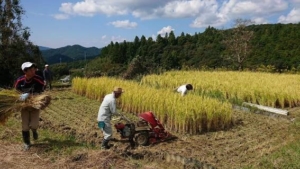2022.10.07
Terraced Rice Paddies in Kurumeki Region
Have you ever heard of the terraced rice paddies in Japan? Rice is the staple of Japanese cuisine and requires paddies with abundant water to grow. However, Japan is a mountainous country and cannot cultivate rice in that terrain. In order to overcome this obstacle, Japanese people developed tiered rice paddies to better leverage Japan’s mountainous landscape for food production.
During the spring planting season, the surrounding scenery is beautifully reflected in the mirror-like surface of the terraced rice paddies’ water. The golden ears of rice reach for the sky during the harvest period in autumn, painting a vivid contrast against the sky of blue above.
This beautiful scenery is only preserved thanks to the labour of local farmers, as the introduction of large-scale machinery into these terraced rice paddies is difficult. Japan has seen a reduction in the number of terraced rice paddies, due to both the aging population of farmers and the depopulation of rural areas. As a result, the country is currently facing a nationwide loss of terraced rice paddy landscapes.
Hamamatsu is home to Kurumeki’s Terraced Rice Paddies, which boasts one of the largest scale rice paddies in Shizuoka Prefecture. At an elevation of around 250 metres, it is located in the mountains north of Hamamatsu, with 800 rice paddies totaling an area of roughly 7.7ha. Its beautiful scenery has been given the titles of “Linking Heritage of Terraced Rice Paddies” and “Recognized Cultural Property of Hamamatsu City,” and won the “Shizuoka Prefecture Landscape Award”.
Like other terraced rice paddies in the country, Kurumeki was once in danger of disappearing. However, it is still being perfectly preserved thanks to the joint efforts of the “Kurumeki Satoyama no Kai”, a group of local farmers, and the “Kurumeki Ryugu-kozo no Kai”, a group of outside supporters who want to pass the beautiful rice paddies on to future generations.
The area is home to the local legend of “Ryugu-kozo”. He is said to have secretly aided the villagers and was buried under a tree in the area after his death. Not shortly after, water came gushing forth from the roots of said tree, which the villagers used to build Kurumeki’s terraced rice paddies. In the spirit of Ryugu-kozo, who once helped the local villagers and asked for nothing in return, these paddies continue to be protected by both those from the area and further afield.
You can find pictures of the beautiful landscapes at the following website (only in Japanese):https://www.kurumeki.com/









